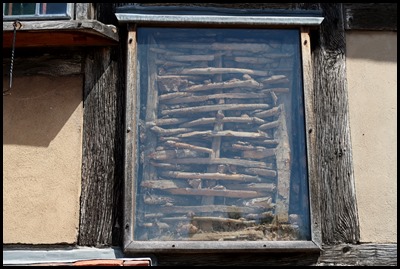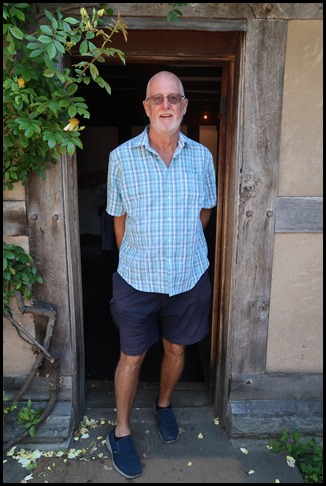Shakespeare’s Birthplace Pt 1

Beez Neez now Chy Whella
Big Bear and Pepe Millard
Fri 29 Jun 2018 22:17
|
Shakespeare’s Birthplace – a House, Museum and Garden
Entertainment – Part One
  We passed Birthplace on the Hop On Hop Off Bus which stopped
at the end of the road, just around the corner. In the sunshine, we bimbled
toward an ice cream and sat to enjoy and watch the world go by for a time before
setting off to explore.
 Seen from the town side, Shakespeare’s Birthplace is a lovely old
building, oozing oodles of charm and character. I was lucky enough to grab a
break in the passers-by to get a picture of Bear outside, on
his own.
  Timber frames and an area of exposed (but
protected) wattle and daub.
.
 To the left corner of the property was
this commemorative stone.
  We showed our tickets and entered the
first part, a museum and a cinema room with an interesting, modern take on the
bard’s works. We sat and watched for fifteen minutes (a loop) as youngsters
performed famous lines. Time for a mooch. A bust of William
on his works and an odd piece in carved Siberian cedar pine called
Sculpture of William Shakespeare by Leonty Usov,
2010, Tomsk, Russia. The split in Shakespeare’s
head represents the
question, ‘To be or not to be’ from Hamlet, Act 3, Scene 1. We took in
the ‘stuff that interested us and here is a selection of information boards in
the order they were presented.
 The First
Folio: This is one of three First Folios cared for by the Shakespeare
Birthplace Trust. The First Folio, or to give it its full title
Mr. William Shakespeare’s Comedies, Histories & Tragedies, was the
first collected edition of Shakespeare’s work. It was published in 1623 by his
fellow actors John Heminges and Henry Condell. Without it we would have lost
more than half of Shakespeare’s plays.
It is thought that between 750
and 1000 copies of the First Folio were printed, and the method of hand-printing
used means that no two copies are the same. In 1623 a copy cost £1 if bound or
15 shillings unbound. To put this in perspective, a Stratford-upon-Avon School
Teacher then earned about £20 a year.
Around 230 First Folios have
survived and are among the most valuable books in the world.
Details: Mr. William Shakespeare’s Comedies,
Histories & Tragedies, written by WIlliam Shakespeare, printed in 1623
by William and Isaac Jaggard, and Edward Blount, London. Once in the library
collection of Betram, 4th Lord Ashburnham, this copy is known as the Ashburnham
Folio. It was rebound during the 1800s, but is otherwise a near perfect
edition.
  The list of
Shakespeare’s works.
Shakespeare’s London was dangerous, manic and
bursting with creativity. The world of the theatre reflected this. Being an
actor himself, Shakespeare knew how to please the audiences of his day. He
understood the actors he wrote for: what the boys playing the women could do
with the poetry and the jokes, and how his friends could play the leading roles
he created.
Shakespeare was fortunate to have wealthy Henry
Wriothesley, the 3rd Earl of Southampton, as his patron. His poems Venus
& Adonis (1593) and The Rape of Lucrece (1594) are dedicated to
him. As his reputation and fame grew he was able to become an actor-manager with
a share in the Globe Theatre, built in 1599. Shakespeare was invited to perform
at court for Elizabeth I and he and his colleagues took part in the procession
for King James I’s coronation in 1603.
From his humble origins in
Stratford-upon-Avon, William Shakespeare went on to write 37 plays, 154 sonnets
and 5 titled poems – leaving us a legacy of nearly a million words of
text.
  Court of
Recordings proceedings, Stratford-upon-Avon, 1553 – 1601. The Court of
Record provided a venue for the settling of civil disputes, for example small
debts. It was frequently used by local businessmen. William’s father, John
Shakespeare, appeared several times. Entries in this volume describe him as a
glover, a yeoman farmer and a ‘whittawer’ – a worker in white
leather.
The Book of
Common Prayer, 1596, provided the format for Church of England religious
services. This copy contains two signatures, ‘W Shakespeare’ and ‘William
Shakespeare’, leading to speculation that he may once have owned it. They are
now widely believed to be later forgeries. Printed by the deputies of
Christopher Barker, London, England.
   The Methuen
Shakespeare. Sculpture based on the Cobbe portrait of William Shakespeare
by Judy Methuen. 2014. I shower a welcome on ye – welcome all. All is
True (Henry VIII) Act 1 Scene 4. Judy Methuen has been working in the world of
visual arts for the past 30 years. Based in Warwickshire, her creative output is
wide-ranging and includes painting, sculpture and costume
production.
Portrait of William Shakespeare’s
wife. Nathaniel Curzon. 1708. Digital image on canvas. Modern reproduction of
the pen and ink original owned by Colgate University, USA. This may be the only
surviving portrait of Anne Hathaway, Shakespeare’s
wife. It was discovered inside a copy of the Third Folio of William
Shakespeare’s works and might have been traced from a lost Elizabethan original.
Reproduced by permission of Special Collections and University Archives, Colgate
University Libraries, USA.
Portrait of a lady, possibly William Shakespeare’s granddaughter, Elizabeth.
Artist unknown. 1690s. Oil on canvas. Possibly a painting of Elizabeth Hall in
later life when she married Sir John Barnard, her second husband, in 1649 and
died in 1670. This portrait once belonged to Thomas Hart, a descendant of
Shakespeare’s sister Joan.
  Taking a break in the garden............
  ..........we were thoroughly
entertained by members of a local theatre group who
did “famous bits by request”. They swapped roles for the balcony scene,
for a laugh and the chap had us in hysterics as he camped up poor
Juliet.
Shakespeare’s Family: William’s
parents were John and Mary Shakespeare. John was the son of a tenant farmer from
south Warwickshire. As a young man he moved from the countryside to the town of
Stratford-upon-Avon, learning the trade of a glover and later running his own
business.
In 1552 he was one of several
people fined for creating a muck heap here on Henley Street, where in 1566 he
bought a family home. A year later he married Mary Arden and William, their
eldest son, was born here in 1564.
John and Mary were ambitious for
themselves and their family. John’s business interests included glove making,
wool dealing and moneylending. He also performed various civic roles, rising to
become Bailiff of the town (similar to Mayor) in 1568.
Like his father, William grew up
to be a clever businessman. By about 1592 he was part of a vibrant theatre
community in London. His success enabled him to buy a coat of arms for John in
1596. The following year he purchased New Place, the largest house in the centre
of Stratford-upon-Avon.
Family Ties:
William Shakespeare grew up surrounded by his younger brothers, Gilbert, Richard
and Edmund, and sisters Joan and Anne. Sadly, when William was a teenager, Anne
died aged 7. To mark her death, their father paid for the funeral bell to be
rung and for a special cloth – a pall – to cover her coffin.
Of his brothers, Gilbert was
closest to William in age and they probably attended the local grammar school
together. When they grew up, he helped William with business matters in
Stratford-upon-Avon. In 1602 William purchased 107 acres of land and a note on
the sale papers reads: Sealed and deliv(er)ed to Gilbert
Shakespeare.
Watching travelling players
performing in the town probably gave William and his siblings their first
experience of theatre. His youngest brother, Edmund, followed him into the
theatrical world as an actor in London.
William’s sister Joan remarried
in Stratford-upon-Avon. She outlived him, the only sibling to do so, and he left
her his clothes, a life tenancy in part of the family home on Henley Street, and
£20.
 Family
Tree:- William Shakespeare was the oldest surviving child of John
Shakespeare and his wife Mary Arden. The couple had two daughters who died as
babies before William was born, and then went on to have five more children.
Shakespeare was born in the same year that plague hit the town of
Stratford-upon-Avon and he was lucky to survive.
At the age of 18, William married
Anne Hathaway who lived in nearby Shottery. They had three children – Susanna
and then twins, Hamnet and Judith. Like his parents, he suffered the loss of a
child when his son Hamnet died aged 11.
Shakespeare lived to know one of his four
grandchildren. Elizabeth Hall was his only grandchild to marry. She had no
children, so there are no direct descendants of William
Shakespeare.
Timeline we saw as
we left the museum: 1552. John Shakespeare is fined on 29 April for leaving
a pile of muck outside his house in Henley Street, known today as the
Birthplace.
1557. John Shakespeare marries
Mary Arden. Mary was a land-owner, having inherited her father’s farm the year
before her marriage.
1564. William Shakespeare is
born, the third child of eight and the eldest surviving son.
1571. From about the age of 7,
William Shakespeare attended the local Grammar School, established by King
Edward VI to offer all of the town’s boys free education. There he learnt Latin
and Greek, which taught him how powerful language can be. He probably
left school around the age of 16.
1582. In November William
Shakespeare marries Anne Hathaway, the daughter of a local
farmer.
1583. Susanna, William’s first
child is born and baptised on 26 May 1583.
1585. Shakespeare’s twins, Hamnet
and Judith, are born and baptised on 2 February 1585.
1596. William Shakespeare’s only
son Hamnet dies aged 11 and is buried on 11 August 1596.
1597. William Shakespeare
purchases New Place, the largest residential house in the centre of
Stratford-upon-Avon, for about £120.
1601. William's father, John
Shakespeare, dies.
1607. Shakespeare’s daughter
Susanna marries John Hall, a respected physician, on 5 June 1607 in Holy Trinity
Church, Stratford-upon-Avon. The couple live at Hall’s Croft until the death of
WIlliam Shakespeare in 1616, when they move into New Place.
1608. Shakespeare’s mother Mary
dies. Shakespeare’s granddaughter Elizabeth Hall is born and baptised on 21
February 1608. She was the only one of Shakespeare’s grandchildren to be born in
his life-time.
1609. Shakespeare’s Sonnets are
published for the first time.
1616. WIlliam Shakespeare dies
and is buried in the chancel of Holy Trinity Church, Stratford-upon-Avon.
1623. Anne, Shakespeare’s widow,
dies age 67 on the 6th of August 1623.
1623. November/December
Mr. William Shakespeare’s Comedies, Histories & Tragedies is
published for the first time. Known today as the First Folio.
 Shakespeare’s Life. William Shakespeare’s life began here in
Stratford-upon-Avon in 1564. Although his career as an actor, theatre manager
and playwright took him to London, Shakespeare remained a country boy at heart.
He returned here often to visit his family, use his library and to write in
familiar surroundings.
You are about to enter the house where Shakespeare was born, the
place he played with his brothers and sisters as a child. It is where he spent
his early adult life, where his children were born and is the house he inherited
from his father.
His family life
at the Birthplace helped form Shakespeare into the
genius he became.
  I am old and fragile please do
not shake my branches......Bear saw the sign by
the tree first, thought it highly appropriate and posed..... Approaching the
side door of Birthplace, we could see the tiny
windows.
 In through the
door of the part of the property where the Bard was born.
CONTINUED.......... |